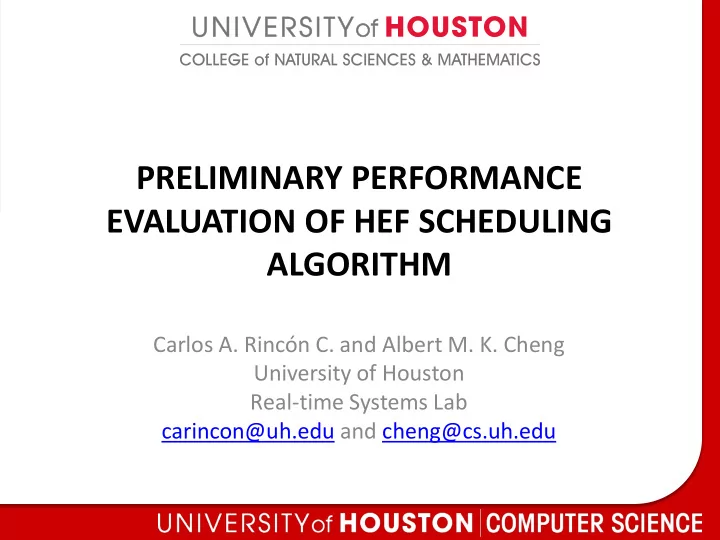

PRELIMINARY PERFORMANCE EVALUATION OF HEF SCHEDULING ALGORITHM Carlos A. Rincón C. and Albert M. K. Cheng University of Houston Real-time Systems Lab carincon@uh.edu and cheng@cs.uh.edu
OUTLINE • Motivation • Related work • Methods and Results • Conclusion and future work - 2 -
MOTIVATION The purpose of the research is to measure the performance of the highest entropy first scheduling algorithm in order to have a guideline about the behavior of the studied algorithm under certain conditions. The contributions of this paper are: • Generate multiple task sets by implementing the programs from the SNU real-time benchmark [1] in Wind River Work-bench 3.3 [2] to calculate the WCET. Also, derive the periods by using a linear programming solution aiming to maximize the utilization of the system based on a predefined hyper-period. • Measure the performance of the HEF algorithm to schedule real-time tasks using as metrics the number of context switches and deadline-miss ratio. - 3 -
RELATED WORK ENTROPY AND REAL-TIME SYSTEMS Rincon and Cheng [3] proposed the mathematical background for using entropy as a parameter to schedule real-time tasks: Total Entropy of a Task: ( H SU =Entropy of a single unit of time of the scheduling diagram). Total Normalized Entropy of a Task: Total Entropy of the System: Relationship between HSys and Utilization: we know that the maximum value of entropy is equal to log2(number of possible cases = hperiod), then HSys ≤ log2(hperiod). Based on this inequality we have: - 4 -
RELATED WORK HIGHEST ENTROPY FIRST ALGORITHM 1. Determine the schedulability of the given task set using the proposed relationship. 2. Calculate NHTask and HTask for each task. 3. Select the task to be executed using the following criteria: a. Select the task with the highest NHTask . b. If two or more tasks have the highest NHTask , then select the task with the highest HTask . c. If two or more tasks have the highest HTask and one of these tasks is the one running, then select the task that is running (to minimize preemption), else select the task based on its process identifier (PID). 4. Update the values of T i and C i for all tasks. 5. Go to step 2 until time = hperiod. - 5 -
METHODS AND RESULTS Task set Generation Preliminary Results 45 44 20 16 0 0 0 0 2 3 4 5 Missed� Deadlines Context� Switches - 6 -
CONCLUSIONS AND FUTURE WORK • We proposed a methodology to generate task sets using the programs from the SNU real-time benchmark (using Wind River Workbench to calculate the WCET of the tasks and a linear programming solution to set the periods). • The results showed: 1. The number of context switches is directly proportional to the number of tasks in the task set. 2. For the deadline-miss ratio, further analysis must be made to confirm that it depends on the utilization of the system (U ≤ 1 = no deadline misses). • We propose as future work to compare the performance of HEF against Earliest Deadline First (EDF) [4]. - 7 -
REFERENCES [1] “ Snu real-time benchmark suite,” http://archi.snu.ac.kr/realtime/benchmark. [2] WindRiver, “Wind river workbench,” http://www.windriver.com. [3] C. A. Rincon and A. M. Cheng, “Using entropy as a parameter to schedule real-time tasks,” in Real-Time Systems Symposium. WiP Session, 2015 IEEE, Dec 2015, pp. 375 – 375. [4] C. Liu and J. Layland, “Scheduling algorithms for multiprogramming in a hard- real-time environment,” J. ACM, vol. 20, no. 1, pp. 46 – 61, 1973. QUESTIONS ? Albert M. K. Cheng University of Houston – Universidad del Zulia cheng@cs.uh.edu - 8 -
Recommend
More recommend